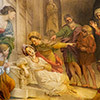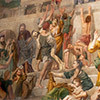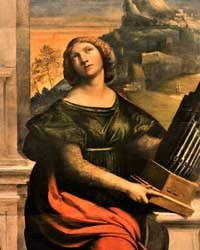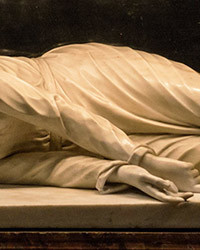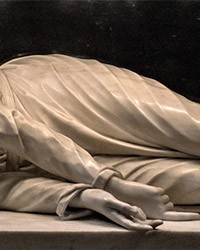Polet Chapel – a monument to the counter-reformation virtues of a French wine merchant
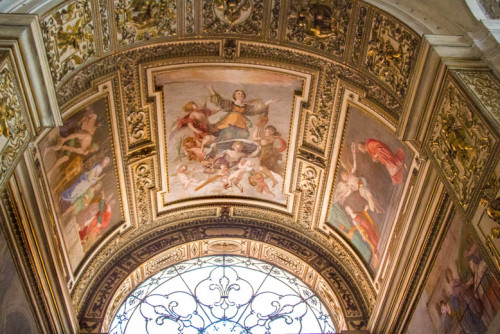
Vault of the Polet chapel, frescoes by Domenichino, Church of San Luigi dei Francesi
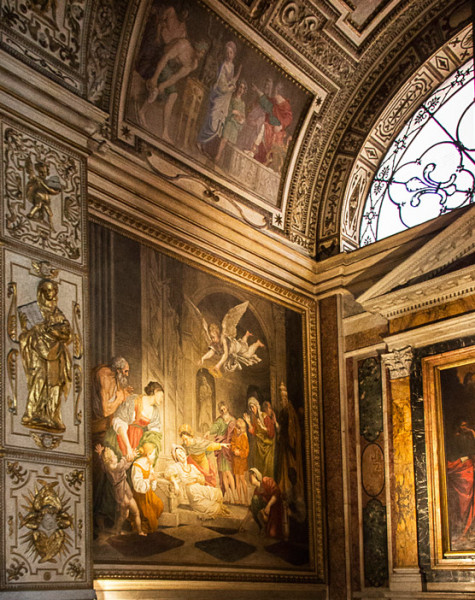
Polet Chapel, Church of San Luigi dei Francesi
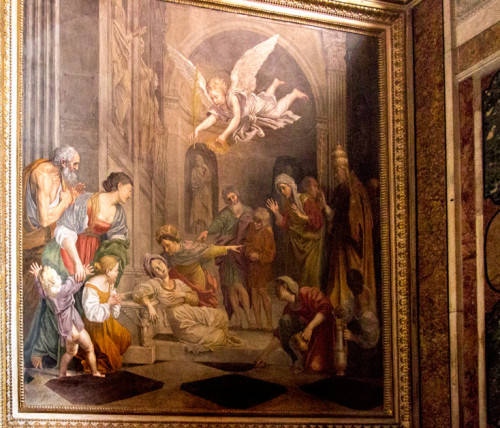
The martyrdom of St. Cecilia, Domenichino, Polet Chapel, Church of San Luigi dei Francesi

The martyrdom of St. Cecilia, fragment, Domenichino, Polet Chapel, Church of San Luigi dei Francesi
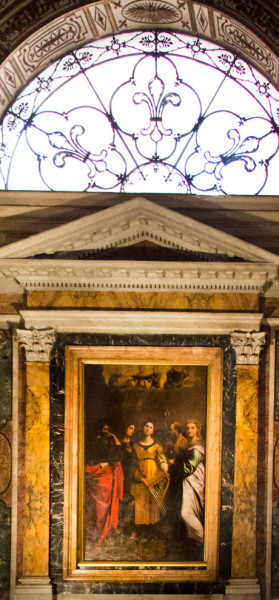
Altar of the Polet Chapel, Saint Cecilia with the saints - a copy after a painting by Raphael, Church of San Luigi dei Francesi
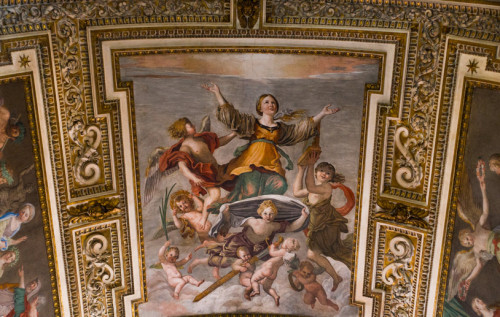
Assumption of Mary, Domenichino, Polet Chapel, Church of San Luigi dei Francesi

Saint Cecilia giving alms, fragment, Domenichino, Polet Chapel, Church of San Luigi dei Francesi
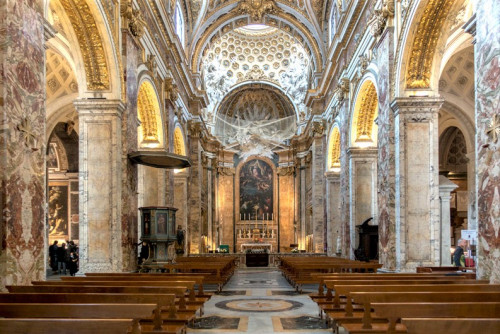
Church of San Luigi dei Francesi, interior
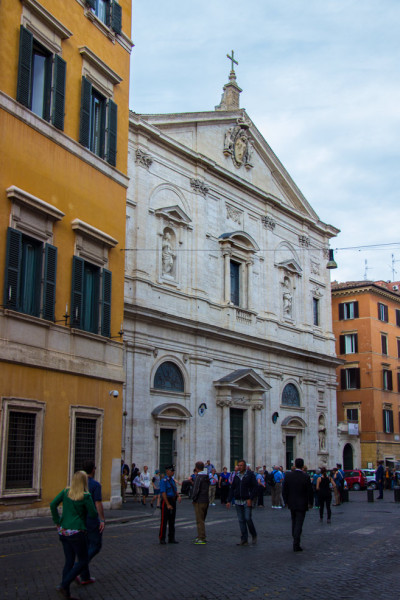
Facade of the Church of San Luigi dei Francesi
The Roman career of Domenichino was hanging by a thread. First the death of Pope Clement VIII, whose nepot (Pietro Aldobrandini) was the artist’s patron, and then the death of his master Annibale Carracci (1609) meant that commissions no longer came. And only on the eve of his departure for Bologna, the painter obtained a very prestigious commission, namely the painting of The Last Communion of St Jerome, to be quickly followed by a series of frescoes concerning the life of St. Cecilia. These frescoes were ordered by a wealthy merchant as an element of the decoration of the Roman French community church – the San Luigi dei Francesi and became the turning point in the career of Domenichino.
The Roman career of Domenichino was hanging by a thread. First the death of Pope Clement VIII, whose nepot (Pietro Aldobrandini) was the artist’s patron, and then the death of his master Annibale Carracci (1609) meant that commissions no longer came. And only on the eve of his departure for Bologna, the painter obtained a very prestigious commission, namely the painting of The Last Communion of St Jerome, to be quickly followed by a series of frescoes concerning the life of St. Cecilia. These frescoes were ordered by a wealthy merchant as an element of the decoration of the Roman French community church – the San Luigi dei Francesi and became the turning point in the career of Domenichino.
The artist was faced with a new task which was to make him famous and forever etch his name in art history. Domenichino's frescoes were praised by his biographer – the then art critic Giovanni Bellori, but also by the art expert Giovanni Battista Agucchi, who saw in them a testimony of the talent, erudition, and humanistic education of their author. They also testified to his ability to combine ancient inspirations with those taken from the works of the Cinquecento masters (Raphael, Annibale Carracci), which today we would simply call eclecticism.
However, who was the man responsible for the commission? We do not know much about Pierre Polet, a wine merchant from Picardy, who had been living in Rome for years. Along with his wife Margarita Rivaldi (who died in 1605), the rich daughter of the prosecutor of the Church of San Luigi dei Francesi, he had a daughter by the name of Lucretia. He himself was a member of the Fraternity of St. Louis, active at the church, which brought together the laity from a charity organization, which was tasked with aiding ill French pilgrims during their stay in Rome, but also care over orphans, widows, and the poor who inhabited the city. In addition, the organization funded dowries for young women and financed the funerals of the poor. The fact that Polet was a wealthy man can be testified to by the splendor of the chapel which he purchased from the fraternity, which also dealt with financial matters of the church. The agreement concluded in 1611 also spoke of purchasing “the spiritual care” belonging to the chapel which included regularly celebrated (within the chapel) masses for the soul of the owner and his daughter (there was no mention of his wife in the notarial deed). Only the very rich could allow themselves such a gesture. More often than not families lost chapels funded by their ancestors since they were unable to pay the annual rent for their upkeep. However, as can be seen, financial matters were not a problem for Polet, the guarantee of his abilities in the field was a tenement house in the city center (on via Madama) along with its commercial property, which he ceded on behalf of the aforementioned fraternity. It was Polet's duty to furnish the chapel both in parameters, as well as wall decorations – in this case, these were rich stuccos, gildings, stucco frames, and Domenichino's paintings. The paintings were to concern a specific topic – the patron and intercessor of the family – St. Cecilia.

And so, on one side Polet wanted to see Cecilia giving out alms, and on the other the scene of her martyr’s death. The topic of the rest of the paintings, meaning the three small frescoes on the chapel vault, was left up to the imagination of the painter, under the condition that they would show the life of the saint. The choice of Cecilia after the miraculous discovery of her untouched body in 1599, fit perfectly with the program of the church itself, in which music had been doted on for years. It is in this very church that an important center of sacral music in Rome was located, an excellent choir was active, while in the nineties of the XVI the kapellmeisters included such great musicians as Ruggerio Giovanelli and Palestrina. Saint Cecilia as the patron of church music was in a particular way venerated in France, but also in the Church of San Luigi dei Francesi itself, especially since the time it housed her relics ( a part of arm and other bones), whose very existence in a clear way contradicted the story of the miraculous discovery (see: Maderno’s Lying St. Cecilia), but did nothing to disturb her cult.
Pierre Polet died in 1612, not living long enough to see the chapel completed but he would have most likely been pleased with the results of Domenichino’s work.
The Polet Chapel is especially richly decorated – multi-colored marbles and gilded stuccos constitute a costly frame for the frescoes. Three of them, found on the vault and decorated with golden frames, depict the Assumption of St. Cecilia (in the middle), the Coronation of St. Cecilia and her Husband Valerian, and the Trial of St. Cecilia, and they do not show any great mastery, while the central and the largest scene is a strong reference to one of the works of Domenichino’s teacher, Carracci (Cerasi Chapel in the Church of Santa Maria del Popolo).

The painting found in the chapel altar is a copy of the work of Raphael, depicting Cecilia accompanied by the saints. How did it come to be in this place, we do not know. It was painted Domenichino’s fellow painter – Guido Reni, or someone from his circle in Bologna, where Raphael’s original was housed. It was ordered by the titular cardinal of the Church of Santa Cecilia, Paolo Camillo Sfondrati, initially for his own collection, which it was still a part of in mid-1615. Was it gifted by this great proponent of the cult of St. Cecilia and an enthusiast of Raphael to the Church of San Luigi di Francesi? Some historians claim that Polet had wanted to employ Reni to complete the decorations of his chapel, but due to numerous commissions, the artist rejected the task – was the painting therefore to be a kind of reparation for this rejection, it is difficult to say.
However, let us move on to Domenichino’s frescoes which adorn the chapel walls, and which aroused such great interest of his contemporaries. The most interesting fresco is the one entitled Saint Cecilia Distributing Alms, showing her as she gives away her exquisite robes and fabrics. However, it is not those fabrics on which the attention of the painter is focused, but rather on the poor standing underneath the balcony, who express neither gratitude nor humility for receiving such gifts. Most likely the client had wanted to underline the saint’s charity which he himself was to imitate, being active in the Fraternity of St. Louis.
On the other side of the chapel, we will see another scene selected by the client – the death of the saint in her own house, surrounded by servants and Pope Urban I. Let us recall, that after three unsuccessful attempts to cut her head off with a sword she died due to blood loss. The expression of the people accompanying this event is of great significance. It underlines the exemplariness of being martyred for the faith, in which witnesses take part – each in their own way experiencing this act of courage and heroism. Their various gestures express fear, pious fascination, and compassion. The women are collecting Cecilia's blood from the floor into jugs (as relics) since in the XVII century it was wrongly believed that it was this blood that filled the vials found in the catacombs. Others show their children the exemplary behavior of the saint, who not only gave her life up for faith but also passed all her fortune on to the Church. It is these very witnesses of Cecilia’s martyrdom who will constitute the Church led by Pope Urban I (shown on the right), which would be established – according to a legend – in the place of her death. In this way, the Polet Chapel became a true propaganda work of the Counterreformation period – it encouraged aid to the poor, but also generosity towards the Church.
For Bellori, the classical art of Domenichino was a polar opposite of the naturalist painting presented by Caravaggio, whose work could be admired on the other side of the church in the Contarelli Chapel. And this opinion of his critic was decisive in Domenichino's work becoming a perfect example of the art of the XVII century. On the other hand, the work of Caravaggio was slowly forgotten, deemed by the same critic as brutal, inelegant, and tactless. Today nobody remembers Domenichino, but everybody is amazed at the works of Caravaggio.
Each person can compare their talents, visiting the Church of San Luigi dei Francesi.













